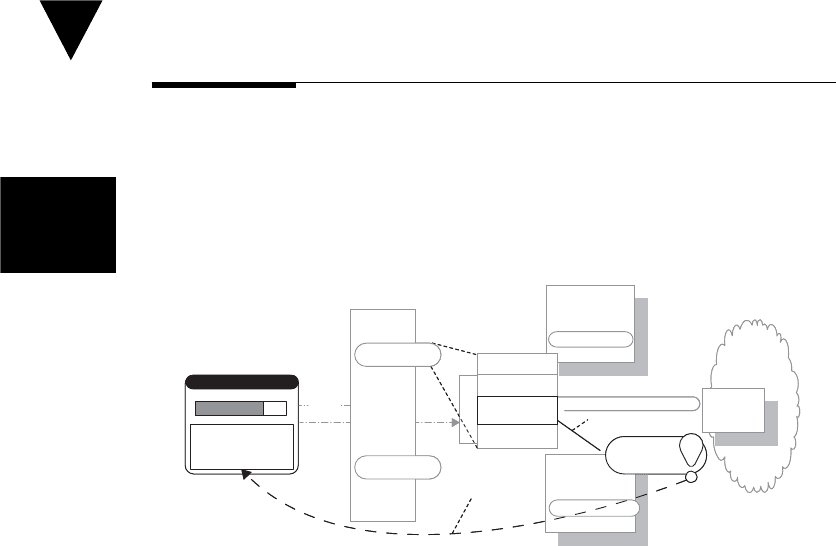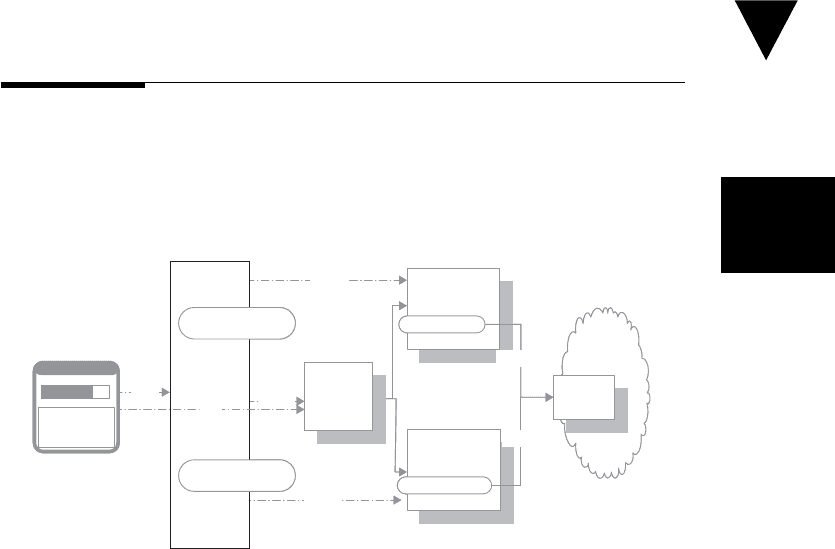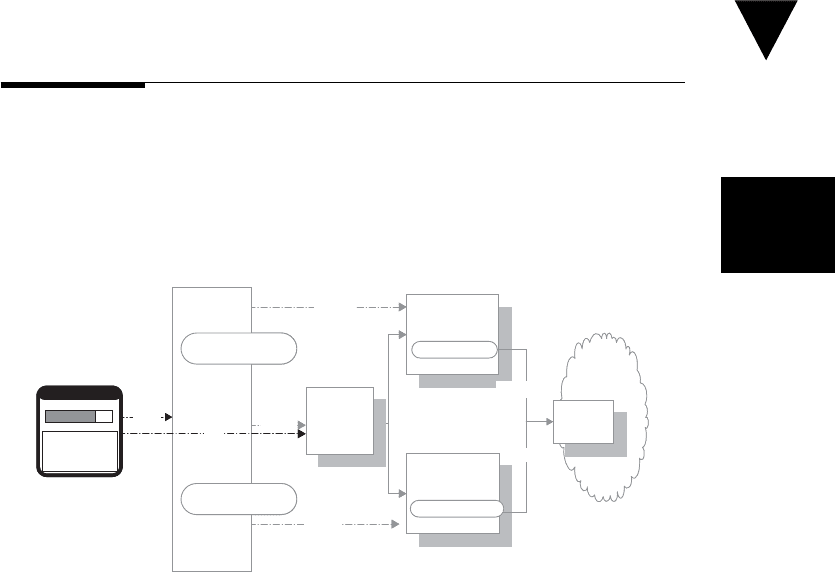Meszaros G. xUnit Test Patterns Refactoring Test Code
Подождите немного. Документ загружается.


Yikes! That got pretty messy. And we’ll have to do the same thing for every
attribute we want to verify? This is not good. There must be a better way.
Refactoring Notes
Luckily for us, the inventors of xUnit recognized this problem and did the requisite
Extract Method [Fowler] refactoring to create a library of Assertion Methods that
we can call instead. We simply replace the mess of in-line if statements and thrown
exceptions with a call to the appropriate Assertion Method. The next example is
the code for the JUnit assertEquals method. Although the intent of this example
is the same as the code we wrote earlier, it has been rewritten in terms of guard
clauses that identify when things are equal.
/**
* Asserts that two objects are equal. If they are not,
* an AssertionFailedError is thrown with the given message.
*/
static public void assertEquals(String message,
Object expected,
Object actual) {
if (expected == null && actual == null)
return;
if (expected != null && expected.equals(actual))
return;
failNotEquals(message, expected, actual);
}
The method failNotEquals is a Test Utility Method that fails the test and provides
a diagnostic assertion message.
Example: Equality Assertion
Here is the same assertion logic recoded to take advantage of JUnit’s Equality
Assertion:
assertEquals( x, y );
Here is the same assertion coded in C#. Note the classname qualifi er and the
resulting difference in the method name:
Assert.AreEqual( x, y );
Example: Fuzzy Equality Assertion
To compare two fl oating-point numbers (which are rarely ever really equal), we
specify the acceptable differences using a Fuzzy Equality Assertion:
Assertion
Method
368
Chapter 19 xUnit Basics Patterns

assertEquals( 3.1415, diameter/2/radius, 0.001);
assertEquals( expectedXml, actualXml, elementsToCompare );
Example: Stated Outcome Assertion
To insist that a particular outcome has occurred, we use a Stated Outcome
Assertion:
assertNotNull( a );
assertTrue( b > c );
assertNonZero( b );
Example: Expected Exception Assertion
Here is an example of how we verify that the correct exception was raised when
we have blocks. In Smalltalk’s SUnit, it looks like this:
self
should: [Flight new mileage: -1122]
raise: RuntimeError new 'Should have raised error'
The should: indicates the block of code to run (surrounded by square brackets),
while the raise: specifi es the expected exception object. In Ruby, it looks like
this:
assert_raises( RuntimeError,
"Should have raised error")
{flight.setMileage(-1122) }
The Ruby language syntax also lets us use this “control structure”-style syntax
by delimiting the block using do/end instead of curly braces:
assert_raises( RuntimeError, "Should have raised error") do
flight.setMileage(-1122)
end
Example: Single-Outcome Assertion
To fail the test, use the Single Outcome Assertion:
fail( "Expected an exception" );
unfinishedTest();
Assertion
Method
Assertion Method
369

Assertion Message
How do we structure our test logic to know which assertion failed?
We include a descriptive string argument in each call to an
Assertion Method.
We make tests Self-Checking (see page 26) by including calls to Assertion Meth-
ods (page 362) that specify the expected outcome. When a test fails, the Test
Runner (page 377) writes an entry to the test result log.
A well-crafted Assertion Message makes it very easy to determine which asser-
tion failed and exactly what the symptoms were when the failure happened.
How It Works
Every Assertion Method takes an optional string parameter that is included in the
failure log. When the condition being asserted is not true, the Assertion Message is
output to the Test Runner’s log along with whatever output the assertion method
normally generates.
When to Use It
There are two schools of thought on this subject. Test drivers who belong to the
“single assertion per Test Method” school believe that they don’t need to include
Assertion Messages because only one assertion can possibly fail and, therefore,
they always know exactly which assertion happened. They count on the Assertion
Method to include the arguments (e.g., expected “x” but was “y”) but they don’t
need to include a message.
Testcase
Object
testMethod_1
Testcase
Object
testMethod_n
Test
Test Failed:
message
Suite
Object
Create
Fixture
SUT
run
Setup
Exercise
Teardown
Assertion
Method
message
message
Testcase
Class
testMethod_1
testMethod_n
Suite
Test Runner
Verify
Testcase
Object
testMethod_1
Testcase
Object
testMethod_n
Test
Test Failed:
message
Suite
Object
Create
Fixture
SUT
run
Setup
Exercise
Teardown
Assertion
Method
message
message
Testcase
Class
testMethod_1
testMethod_n
Suite
Test Runner
Verify
Assertion
Message
Chapter 19 xUnit Basics Patterns
370

Conversely, people who fi nd themselves coding several or many assertion
method calls in their tests should strongly consider including a message that at
least distinguishes which assertion failed. This information is especially impor-
tant if the tests are frequently run using a Command-Line Test Runner (see Test
Runner), which rarely provides failure location information.
Implementation Notes
It is easy to state that we need a message for each assertion method call—but
what should we say in the message? It is useful to take a moment as we write
each assertion and ask ourselves what the person reading the failure log would
hope to get out of it.
Variation: Assertion-Identifying Message
When we include several assertions of the same type in the same Test
Method (page 348), we make it more diffi cult to determine exactly which one
failed the test. By including some unique text in each Assertion Message, we can
make it very easy to determine which assertion method call failed. A common
practice is to use the name of the variable or attribute being asserted on as the
message. This technique is very simple and requires very little thought. Another
option is to number the assertions. This information would certainly be unique
but understanding it may be less intuitive as we would have to look at the code
to determine which assertion was failing.
Variation: Expectation-Describing Message
When a test fails, we know what has actually happened. The big question is,
“What should have happened?” There are several ways of documenting the
expected behavior for the test reader. For example, we could place comments in
the test code. A better solution is to include a description of the expectation in
the Assertion Message. While this is done automatically for an Equality Asser-
tion (see Assertion Method), we need to provide this information ourselves for
any Stated Outcome Assertions (see Assertion Method).
Variation: Argument-Describing Message
Some types of Assertion Methods provide less helpful failure messages than
others. Among the worst are Stated Outcome Assertions such as assertTrue
(aBooleanExpression)
. When they fail, all we know is that the stated outcome did
not occur. In these cases we can include the expression that was being evalu-
ated (including the actual values) as part of the Assertion Message text. The
Assertion
Message
Assertion Message
371

test maintainer can then examine the failure log and determine what was being
evaluated and why it caused the test to fail.
Motivating Example
assertTrue( a > b );
assertTrue( b > c );
This code emits a failure message—something like “Assertion Failed.” From
this output, we cannot even tell which of the two Assertion Messages failed. Not
very useful, is it?
Refactoring Notes
Fixing this problem is a simple matter of adding one more parameter to each
Assertion Method call. In this case, we want to communicate that we are
expecting “a” to be greater than “b.” Of course, it would also be useful to be
able to see what the values of “a” and “b” actually were. We can add both
pieces of information into the Assertion Message through some judicious string
concatenation.
Example: Expectation-Describing Message
Here is the same test with the Argument-Describing Message added:
assertTrue( "Expected a > b but a was '" + a.toString() +
"' and b was '" + b.toString() + "'",
a.gt(b) );
assertTrue( "Expected b > c but b was '" + b.toString() +
"' and c was '" + c.toString + "'",
b > c );
This will now result in a useful failure message:
Assertion Failed. Expected a > b but a was '17' and b was '19'.
Of course, this output would be even more meaningful if the variables had
Intent-Revealing Names [SBPP]!
Assertion
Message
372
Chapter 19 xUnit Basics Patterns

Testcase Class
Where do we put our test code?
We group a set of related Test Methods on a single Testcase Class.
We put our test logic into Test Methods (page 348) but those Test Methods need
to be associated with a class. A Testcase Class gives us a place to host those
methods that we can later turn into Testcase Objects (page 382).
How It Works
We collect all Test Methods that are related in some way onto a special kind
of class, the Testcase Class. At runtime, the Testcase Class acts as a Test Suite
Factory (see Test Enumeration on page 399) that creates a Testcase Object for
each Test Method. It adds all of these objects to a Test Suite Object (page 387)
that the Test Runner (page 377) will use to run them all.
Why We Do This
In object-oriented languages, we prefer to put our Test Methods onto a class
rather than having them as global functions or procedures (even if that is allowed).
By making them instance methods of a Testcase Class, we can create a Testcase
Object for each test by instantiating the Testcase Class once for each Test Method.
This strategy allows us to manipulate the Test Methods at runtime.
Testcase
Object
testMethod_n
Testcase
Object
testMethod_1
Testcase
Class
testMethod_1
testMethod_n
Test
Suite
Object
Exercise
Create
Exercise
Create
Create
Fixture
SUT
Run
Suite
Test Runner
Testcase
Object
testMethod_n
Testcase
Object
testMethod_1
Testcase
Class
testMethod_1
testMethod_n
Test
Suite
Object
Exercise
Create
Exercise
Create
Create
Fixture
SUT
Run
Suite
Test Runner
Testcase
Class
Testcase Class
Also known as:
Test Fixture
373

Class–Instance Duality
Back in high school physics, we learned about the “wave–particle duality”
of light. Sometimes light acts like a particle (e.g., going through a small
aperture), and sometimes it acts like a wave (e.g., rainbows). The behavior
of Testcase Classes (page 373) sometimes reminds me of this concept. Let
me explain why.
Developers new to xUnit often ask, “Why is the class we subclass called
TestCase when we have several Test Methods on it? Shouldn’t it be called
TestSuite?” These questions make a lot of sense when we are focused
primarily on the view of the class when we are writing the test code as
opposed to when we are running the code.
When we are writing test code, we concentrate on the Test Methods. The
Testcase Class is primarily just a place to put the methods. About the only
time we think of objects is when we use Implicit Setup (page 424) and
need to create fi elds (instance variables) to hold them between the invo-
cation of the setUp method and when they are used in the Test Method.
When developers new to xUnit test automation are writing their fi rst tests,
they tend to code by example. Following an existing example is a good
way to get something working quickly but it doesn’t necessarily help the
developer understand what is really going on.
At runtime, the xUnit framework typically creates one instance of the
Testcase Class for each Test Method. The Testcase Class acts as a Test
Suite Factory (see Test Enumeration on page 399) that builds a Test Suite
Object (page 387) containing all the instances of itself, one instance for
each Test Method. Now, it’s not very often that a static method on a class
returns an instance of another class containing many instances of itself.
If this behavior wasn’t odd enough, the fact that xUnit reports the test
failures using the Test Method name can be enough to obscure from many
test automaters the existence of “objects inside.”
When we examine the object relationships at runtime, things become a bit
clearer. The Test Suite Object returned by the Test Suite Factory contains
one or more Testcase Objects (page 382). So far, so good. Each of these
objects is an instance of our Testcase Class. Each instance is confi gured
to run one of the Test Methods. More importantly, each will run a differ-
ent Test Method. (How this happens is described in more detail in Test
Discovery on page 393.) So each instance of our Testcase Class is, indeed,
a test case. The Test Methods are just how we tell each instance what it
should test.
Testcase
Class
Chapter 19 xUnit Basics Patterns
374

Further Reading
Martin Fowler has a great piece on his blog about this issue called “JUnit
New Instance” [JNI].
We could, of course, implement each Test Method on a separate class—but that
creates additional overhead and clutters the class namespace. It also makes it
harder (although not impossible) to reuse functionality between tests.
Implementation Notes
Most of the complexity of writing tests involves how to write the Test Methods:
what to include in-line and what to factor out into Test Utility Methods (page 599),
how to Isolate the SUT (see page 43), and so on.
The real magic associated with the Testcase Class occurs at runtime and
is described in Testcase Object and Test Runner. As far as we are concerned,
all we have to do is write some Test Methods that contain our test logic
and let the Test Runner work its magic. We can avoid Test Code Duplica-
tion (page 213) by using an Extract Method [Fowler] refactoring to factor
out common code into Test Utility Methods. These methods can be left on the
Testcase Class or they can be moved to an Abstract Testcase superclass (see Test-
case Superclass on page 638), a Test Helper class (page 643), or a Test Helper
Mixin (see Testcase Superclass).
Example: Testcase Class
Here is an example of a simple Testcase Class:
public class TestScheduleFlight extends TestCase {
public void testUnscheduled_shouldEndUpInScheduled() throws Exception {
Flight flight = FlightTestHelper.
getAnonymousFlightInUnscheduledState();
flight.schedule();
assertTrue( "isScheduled()", flight.isScheduled());
}
public void testScheduledState_shouldThrowInvalidRequestEx()
throws Exception {
Flight flight = FlightTestHelper.
getAnonymousFlightInScheduledState();
try {
flight.schedule();
fail("not allowed in scheduled state");
Testcase
Class
Testcase Class
375

} catch (InvalidRequestException e) {
assertEquals("InvalidRequestException.getRequest()",
"schedule",
e.getRequest());
assertTrue( "isScheduled()", flight.isScheduled());
}
}
public void testAwaitingApproval_shouldThrowInvalidRequestEx()
throws Exception {
Flight flight = FlightTestHelper.
getAnonymousFlightInAwaitingApprovalState();
try {
flight.schedule();
fail("not allowed in schedule state");
} catch (InvalidRequestException e) {
assertEquals("InvalidRequestException.getRequest()",
"schedule",
e.getRequest());
assertTrue( "isAwaitingApproval()",
flight.isAwaitingApproval());
}
}
}
Further Reading
In some variants of xUnit (most notably VbUnit and NUnit), the Testcase Class is
called a test fi xture. This usage should not be confused with the test fi xture (or test
context) that consists of everything we need to have in place before we can start
exercising the SUT.
3
Neither should it be confused with the fi xture term as used
by the Fit framework, which is the Adapter [GOF] that interacts with the Fit table
and thereby implements a Data-Driven Test (page 288) Interpreter [GOF].
3
These are the pre-conditions of the test.
Testcase
Class
376
Chapter 19 xUnit Basics Patterns

Test Runner
How do we run the tests?
We defi ne an application that instantiates a Test Suite Object and executes
all the Testcase Objects it contains.
Assuming we have defi ned our Test Methods (page 348) on one or more
Testcase Classes (page 373), how do we actually cause the Test Automation
Frameworks (page 298) to run our tests?
How It Works
Each member of the xUnit family of Test Automation Frameworks provides
some form of command-line or graphical application that can be used to run
our automated tests and report on the results. The Test Runner uses Test Enu-
meration (page 399), Test Discovery (page 393), or Test Selection (page 403) to
obtain a Composite [GOF] test object. The latter may either be a single Testcase
Object (page 382), a Test Suite Object (page 387), or a Composite test suite (a
Suite of Suites; see Test Suite Object). Because all of these objects implement the
same interface, the Test Runner need not care whether it is dealing with a single
test or a multilevel suite. The Test Runner keeps track of, and reports on, how
many tests it has run, how many tests had failed assertions, and how many tests
raised errors or exceptions.
Testcase
Object
testMethod_n
Testcase
Object
testMethod_1
testMethod_1
testMethod_n
Test
Suite
Object
Exercise
Exercise
Create
Create
SUT
Run
Test Runner
Fixture
Suite
Testcase
Class
Create
Testcase
Object
testMethod_n
Testcase
Object
testMethod_1
testMethod_1
testMethod_n
Test
Suite
Object
Exercise
Exercise
Create
Create
SUT
Run
Test Runner
Fixture
Suite
Testcase
Class
Create
Test Runner
Test Runner
377
